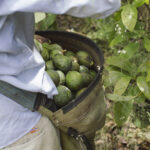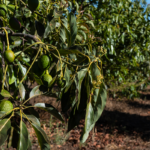California Avocado Commission recognizes female farmers

In honor of International Women’s Day, the California Avocado Commission, which represents growers farming on about 50,000 acres in the state, is sharing profiles of some female avocado farmers to showcase the role of women in the industry.
For a long time, women have been active in growing California avocados. Many California avocado growers come from multigenerational farming families, and with generational transitions happening, increasingly women are taking on avocado grove management and ag industry leadership roles.
“The Commission is happy to celebrate International Women’s Day and the many women involved in the California avocado industry,” said California Avocado Commission Online Marketing Director Zac Benedict. “This month our public relations team conducted outreach to consumer media outlets to share stories of a few of these hard-working farmers.”
Tara Axell Rosenthal
Tara Axell Rosenthal is a fifth-generation California farmer and third-generation California avocado grower. She grew up on the Axell family avocado grove but it wasn’t until 2020, after her father’s passing, that growing avocados became her profession. Her mother, Joanna Axell, is the owner of the family ranch, Rancho Rodoro.
In order to help her mom and the avocado groves, Tara, her brother, Brandon, and her husband Ryan work together to keep everything running smoothly.
Jessica Hunter
Jessica Hunter, who is featured in the article's cover picture, was the first third-generation family member to join the family business after college. After 20 years, she is now CEO of Del Rey Avocado, her family’s avocado-growing and packing company located in San Diego County. Her daily duties include managing the California avocado procurement team and the operations of both the packing and distribution centers on the West Coast.
She also manages more than 100 acres of the company’s avocado groves. Jessica serves on the Executive Committee of the California Avocado Commission board of directors and is an active spokesperson for the California avocado industry.
Catherine Pinkerton Keeling
Catherine Pinkerton Keeling’s family has been growing California avocados for more than half a century, but that didn’t make her a farmer. After college Catherine (and her husband Travis) volunteered for the Peace Corps in Costa Rica, helping women become economically independent as part of a rural development program. She later became a licensed clinical social worker in the Midwest.
In late 2017 when the devasting Thomas Fire destroyed her parents’ home and about 70% of their avocado ranch, Catherine and Travis felt a calling to help her family rebuild their farm. A passionate advocate for California avocados and sustainable agriculture, Catherine now serves as an alternate on the California Avocado Commission board of directors. In November 2022 she also was elected to the board of directors of the United Water Conservation District.
Hilary Kitzman Wilkie
Hilary Kitzman Wilkie was introduced to growing avocados on her parents’ beautiful avocado grove in Morro Bay, California. She received her degree in computer science and then home-schooled four children. In 2016 when Hilary’s father decided he was getting ready to retire, Hilary and her husband Andrew, who love the farm and had looked forward to assuming responsibility for it, started learning to grow California avocados. Now they manage day-to-day operations. Hilary is proud that the family avocado farm (Kitzman Fair Haven) utilizes a variety of environmentally responsible practices, including using natural leaf mulch and solar energy.
“The stories of these four women are helping to highlight the roles of women in agriculture,” said Benedict. “With more female California avocado growers being available and willing to share, CAC is able to feature their stories on CaliforniaAvocado.com, social media, in marketing materials, and retail programs.”
Benedict noted that the California Avocado Commission’s forecast for this year is 257 million pounds. There was relatively light harvesting in February and volume is expected to ramp up in March with peak availability from April through July.








































